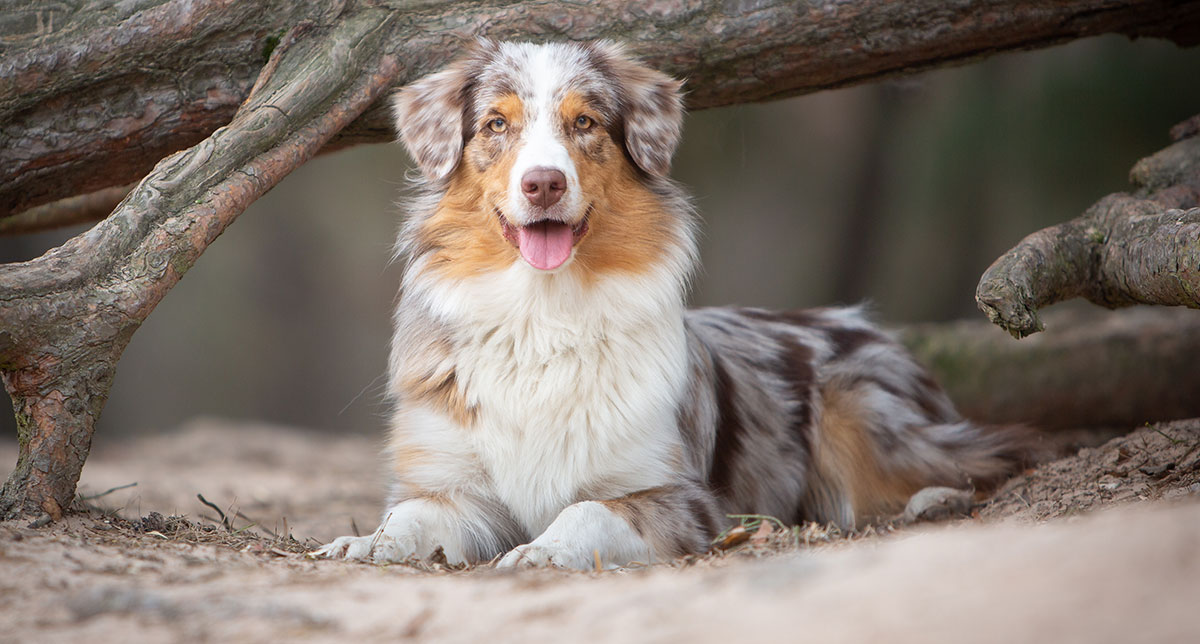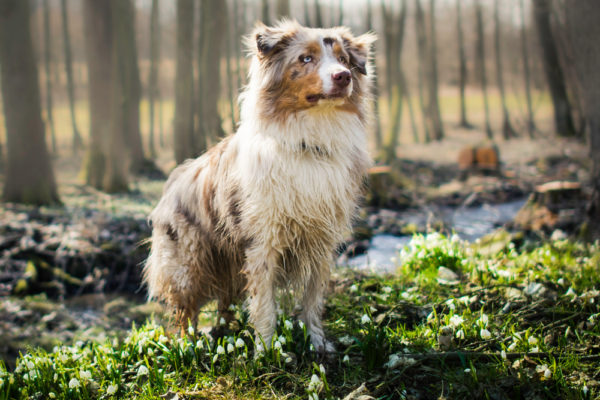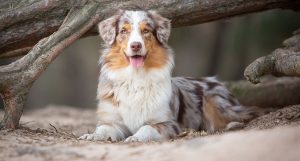
Australian Shepherd

Image: JitkaP/Shutterstock.com
| Name | Australian Shepherd |
|---|---|
| Size | Medium / 23 - 29kg |
| Grooming | Moderate |
| Training | Easy |
| Exercise | Daily / 30 to 60 minutes |
| Origins | Western United States |
The Australian Shepherd Dog – Nothing to do with the German Version
Ranked the 17th most popular breed in America (they’re just so pretty!)
Quick Overview
Name: The Australian Shepherd Dog
Size: 23 inches from shoulder to floor on a male, females up to 21 inches
Weight: 65 pounds or less, 55 or less for the female
Grooming: At least once per week
Training: Desperate to make you happy
Exercise: As much as you can give it
Temperament: Quirky, funny, happy medium-sized balls of love
Origins: The Basque Region of France, we’re not joking.
Lifespan: 12-15 years or more, if you are lucky
Breed Type: PASTORAL/HERDING (Working dog)
A Little History on the Australian Shepherd Dog
The breed history of the Australian Shepherd Dog actually begins away back when, before Australia was filled with immigrants, the plains of Europe were the biggest herding place we knew about. The Great Pyrenees was bred here, the preliminary shepherd dogs to almost every breed on Earth. The border between France and Spain contains a mountain range known as the Pyrenees, and it was for this area that this pastoral breed was named.
Later, the Great Pyrenees would develop a smaller strain of the species, known as the Basque Shepherd. When the owners of these dogs eventually made the migration to Australia and discovered the need for good herding dogs, it became a full-on mission to invent some. Two breeds were formed, one, the hardy Australian Cattle Dog, the other was the Australian Shepherd Dog. How did they do it? With a bit of selective genetics and breeding, of course.
The Basque Shepherd was hardy and fast, wiry, and well-built to herd in the Basque regions of France/France – but not in the searing heat of an Australian summer. At some point, the Aussie newcomers realised they needed to bring in the big guns, so to speak. They imported collies and border collies. They also added Dalmatian to the genetic mix, and it is this set of DNA that parts the Australian Cattle Dog and the Australian Shepherd Dog.
However, the story doesn’t end there by any stretch of the imagination. The Brits, having now created the Australian Cattle Dog, had no further need for the collies and Basque Shepherd Dogs that sweltered in the heat. The Basque was next exported to the sunny plains of California. Here, they could herd all they wanted without dying off in the heat. The Californians, being American, noted the Basque Shepherd Dogs had come from Australia and named them the Australian Shepherd Dog. Yeah.
So now, the Australian Shepherd Dog is the 17th most popular breed in America. Even though they are actually from Basque. They look a lot like an English Collie/Border Collie cross but come in tans and creams as well as blacks and whites. They often have those blue eyes, or even come with mismatched eyes. While cute, you should always get your new pup an eye exam, just to make sure the mismatch isn’t the blindness gene.

Image: pawlove.de/Shutterstock.com
Fun Facts about the ASD
The Australian Shepherd dog has a few fun facts associated, but you already know the first one on the list:
- It’s from The Basque Region. Yes, these famous Australians are actually French at heart!
- They didn’t make it into the American Kennel Club until 1993, despite having been around for a long time.
- The UK Kennel Club advise you take this dog for more than 2 hours of exercise every day, and that you need a large house in the countryside to own one.
- They have settled into the west so much that they are now associated with cowboys and the rancher lifestyle.
- They have a really broad colour range. Most breeds have three or four colours at most, but the ASD has reds, tans, creams, browns, whites, silvers, blacks, oranges – the whole range.
As you can see, the Australian Shepherd has a history, nature, and work ethic, that we are all a little jealous of. They are just such a stunning breed it almost hurts our heart.
General Nature of Australian Shepherd Dogs
These are happy dogs that are eager to please. They just want you to be happy – but they like jobs. They are a working dog, so if you are keeping one as a pet, make sure you stimulate them by giving them responsibilities around the house. Teach them to ‘help out’ by closing doors, fetching, and other small tasks. They long for the reward of doing things for you, so keep them happy. It is your job as an owner.
How Much Training for an ASD?
They are a working breed. If you want to use them to herd your cattle, they will have this in their very bones. It doesn’t take a lot of work to train a dog if you have other working dogs around to show them the ropes. They are also renowned performance dogs and show dogs. They are intelligent enough that you can teach them all sorts of tricks and they will love it. They were born to work. They are never happier than when you are teaching them something.
How Much Grooming does the Australian Shepherd Dog Take?
The AKC says once a week, the UKKC says more than that. If you want a fluffy puppy then once a day is best. Likewise, if you have a working dog that helps on the ranch, you will get away with little to no grooming at all.
Associated Health Concerns
The white/light blue eye associated with this breed is referred to as the Merle gene. This is a dominant gene and does lead to blindness. even though it looks really cute. It is both a recognisable breed trait and a reason to be wary. If you litter two Merle parents there is a high chance of more than one blind pup – so be careful!
Next on the list of health problems beside eyes were skin and breathing issues, but Merle is the worst. A Merle puppy might also be Deaf but there is a lessened risk. You should watch out for hip dysplasia too.
Got Five More Minutes?
If you have enjoyed our little foray into the world of Australian Dog Breeds, then you are sure to love the rest of our pet-focused articles. Need something to do on your break? That’s why Five Minutes Spare exists. Go check out our FB page for inspiration.